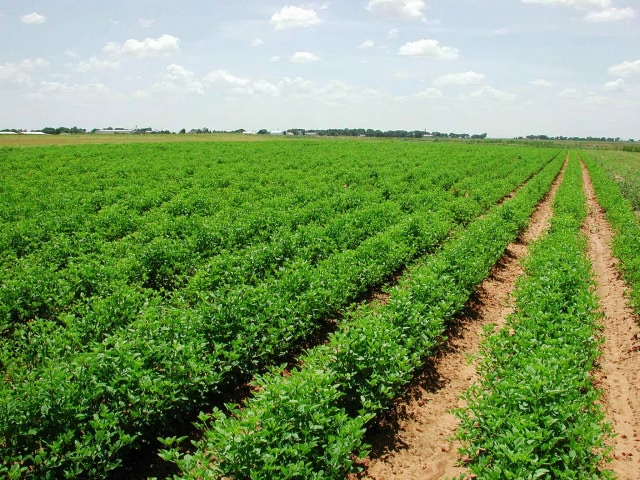ISLAMABAD:
Pakistan’s GDP growth exceeded expectations during FY24. It proved wrong everyone, including international organisations, experts, and policymakers. A deep dive into GDP data revealed that the major push came from agriculture.
Despite bad governance, climatic factors, and a distorted market, agriculture showed remarkable performance. It posted a growth rate of 6.25%, driven by the crop sector, which grew by 11.3%.
Unfortunately, agriculture struggled to sustain momentum in 2025. The growth rate dropped to 0.56% from 6.25% in 2024. The crop sector grew by -6.82% in 2025, compared to 11.3% in 2024. Major crops, such as wheat, sugarcane, cotton, and rice – key contributors to agricultural GDP — faced significant losses.
Wheat experienced a negative growth rate of -8.9%, with the government attributing it to climate change and reduced production areas. Interestingly, for sugarcane and rice, although their cropping areas increased by 1.1% and 7.2%, respectively, their production decreased by -3.4% and -1.38%. Cotton saw the worst decline, contracting by 30.7%.
These figures are very concerning given the ongoing issues of poverty, food insecurity, and unemployment in Pakistan. The World Bank estimated that about 44.7% of the population lives below the poverty line, which is a troubling statistic. Additional analysis reveals that 16.5% of the population is living in extreme poverty. They struggle to meet basic daily needs and face uncertainty about their future.
It has also been predicted that the poor performance of agriculture has contributed to a 0.2% increase in poverty in rural areas. This is a serious situation. Poverty is growing, even though the government claims to be investing in poverty reduction programmes like the Benazir Income Support Programme (BISP). This also raises questions about the effectiveness and sustainability of BISP. Each year, Pakistan spends billions of rupees on BISP. But what is the result? Poverty keeps increasing.
Second, food insecurity remains a major concern. A 2013 study estimated that 58.8% of Pakistan’s population was food insecure. Unfortunately, we are still relying on old data because the government hasn’t updated Pakistan’s food insecurity data. There are concerns that food insecurity has risen over time due to various factors.
First, poor economic conditions and the devaluation of the PKR have significantly reduced people’s purchasing power, leaving fewer resources to buy healthy food. Second, weak governance of the agricultural sector has led to lower production and reduced availability of high-quality food.
The government blames climate change for the poor performance, but a closer look at the data shows that isn’t the full story. The true cause of the agricultural decline is poor governance – the government’s consistent ignorance and pro-market, or specifically pro-private sector, policies.
Now, under the International Monetary Fund (IMF) direction, Pakistan has left farmers at the mercy of the private sector and climate change. It devises and enforces policies that favour the private sector at the expense of farmers. For example, last year, the government allowed market forces or the private sector to dictate and control the agricultural input market. The private sector exploited farmers by manipulating prices and input availability.
Farmers scrambled from one market to another to obtain inputs but faced numerous difficulties. Most farmers were unable to secure the necessary inputs at the right time, which negatively impacted crop production. The farmers were protesting and voicing their concerns, but the government refused to intervene. The government believed that interfering in the market would disrupt free market principles and was, therefore, unwilling to intervene.
On the other hand, the government forgets the free-market principles when it comes to agricultural products. It artificially sets the prices of commodities and forces farmers to sell their commodities at government prices. For example, the Punjab government has announced the wheat price at Rs2,900 per 40kg. It is an injustice to the farmers because it is lower than the cost of production.
The farmers claim that the cost of production for 40kg is around Rs4,000, and the Punjab government is asking them to sell wheat at Rs2,900. In this way, the farmers are incurring a loss of Rs1,100 per 40kg. Now, the question is why the government is interfering in the private market and forcing farmers to sell their product at a loss. Isn’t it against the market law? The government claims that it wants to protect the poor. In this context, then, what about the poor farming community? Why should the government protect the poor at the cost of the poor farming community?
The second example is the sugar crisis. First, the government allowed the sugar industry to export sugar, resulting in an abnormal price increase. Now, it is allowing the same sector to import sugar, and the arrival time will be during the crushing season. It will enable the industry to exploit farmers.
The above discussion suggests that poor governance and government preferences are significantly impacting the agricultural sector, leading to the downfall of the farming community. Unfortunately, this policy is not limited to the present government; the successive governments, political and military, have systematically destroyed agriculture and the farming community.
The fall of farmers will lead to the collapse of agriculture. It will impact the country on multiple fronts, including the unavailability or high cost of inputs, a sharp increase in unemployment, poverty, and food insecurity, among other consequences. Therefore, the government will have to take immediate steps to reverse the process.
It will have to decide on the market structure, either to leave it to market forces with the invisible hand or to adopt a free market approach with the firm visible hand. It is suggested that the government should pursue a free market, but with a strong, visible hand, not an invisible one.
Also, the government will need to develop policies that help farmers lower production costs and enable low-income consumers to afford food. One possible option can be a double-edged subsidy policy. On the one hand, subsidies should be limited to small farmers with landholdings of up to 12.5 acres, in different slabs. For example, farmers with less than one acre should be provided with essential inputs free of charge, and those with 2.5 acres should receive them at half price.
Similarly, farmers with less than 7.5 acres should be given a 30% subsidy, and those with up to 12.5 acres should receive a 20% subsidy. Farmers with 25-50 acres should be entitled only to a 10% subsidy.
A similar formula should be applied on the consumption side. Government should also divide the consumers into four groups: 1) group-1, people connected with BISP, 2) group-2, people with a monthly income of Rs50,000, 3) Rs100,000, and 4) above Rs100,000. The wheat distribution should be as Rs1200/40kg, Rs1800/40kg, Rs2200/40kg, and wheat at market price, among groups, respectively. This strategy will not only help farmers but also shield the urban poor. The same formula can be applied to other commodities, such as grams, onions, garlic, and meat.
THE WRITER IS A POLITICAL ECONOMIST AND A VISITING RESEARCH FELLOW AT HEBEI UNIVERSITY, CHINA









